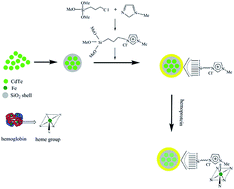Facile synthesis of ionic liquid functionalized silica-capped CdTe quantum dots for selective recognition and detection of hemoproteins
Abstract
A facile and efficient approach for preparation of ionic liquid functionalized silica-capped CdTe QDs (CdTe/SiO2/IL) was proposed in this work. The imidazolium-based ionic liquid N-3-(3-trimethoxysilylpropyl)-3-methyl imidazolium chloride was introduced and anchored on the surface of silica-capped CdTe QDs by the sol–gel technique, which played the role of a recognition element due to the covalent coordination binding between the heme group of hemoprotein and the imidazolium cation in the ionic liquid. The synthetic CdTe/SiO2/IL was further characterized by elemental analysis, transmission electronic microscopy (TEM), X-ray photoelectron spectra (XPS) and Fourier transform infrared spectroscopy (FT-IR). Combining the merits of the fluorescence property of the QDs and the covalent interaction of the ionic liquid with hemoproteins, the CdTe/SiO2/IL exhibited high adsorption capacity and good specificity toward hemoproteins and also was successfully applied in the fluorescence detection of hemoprotein in biological fluid. The strategy provided a promising way to fabricate functionalized fluorescence materials as biomedical/chemical sensors for the separation and detection of hemoproteins in proteomics research.


 Please wait while we load your content...
Please wait while we load your content...